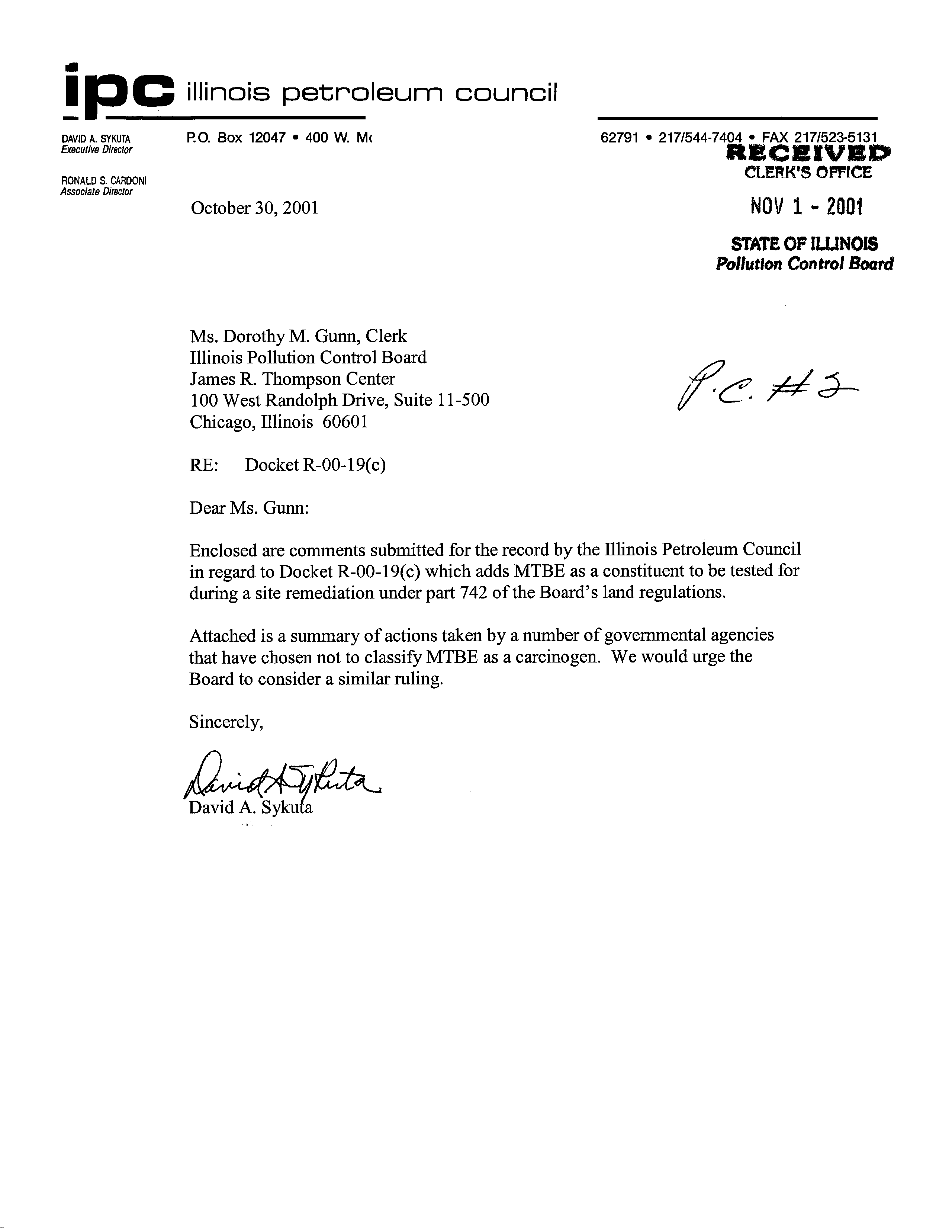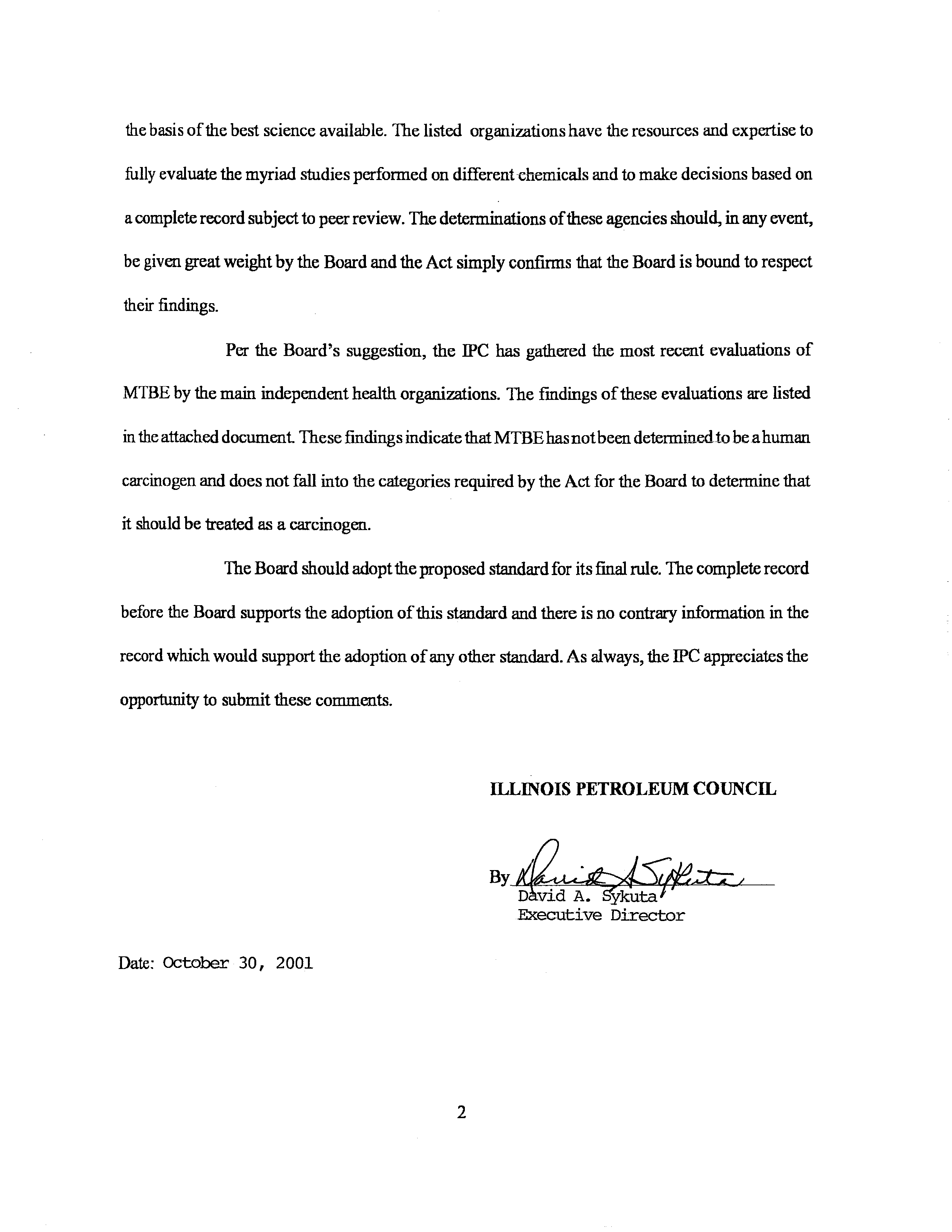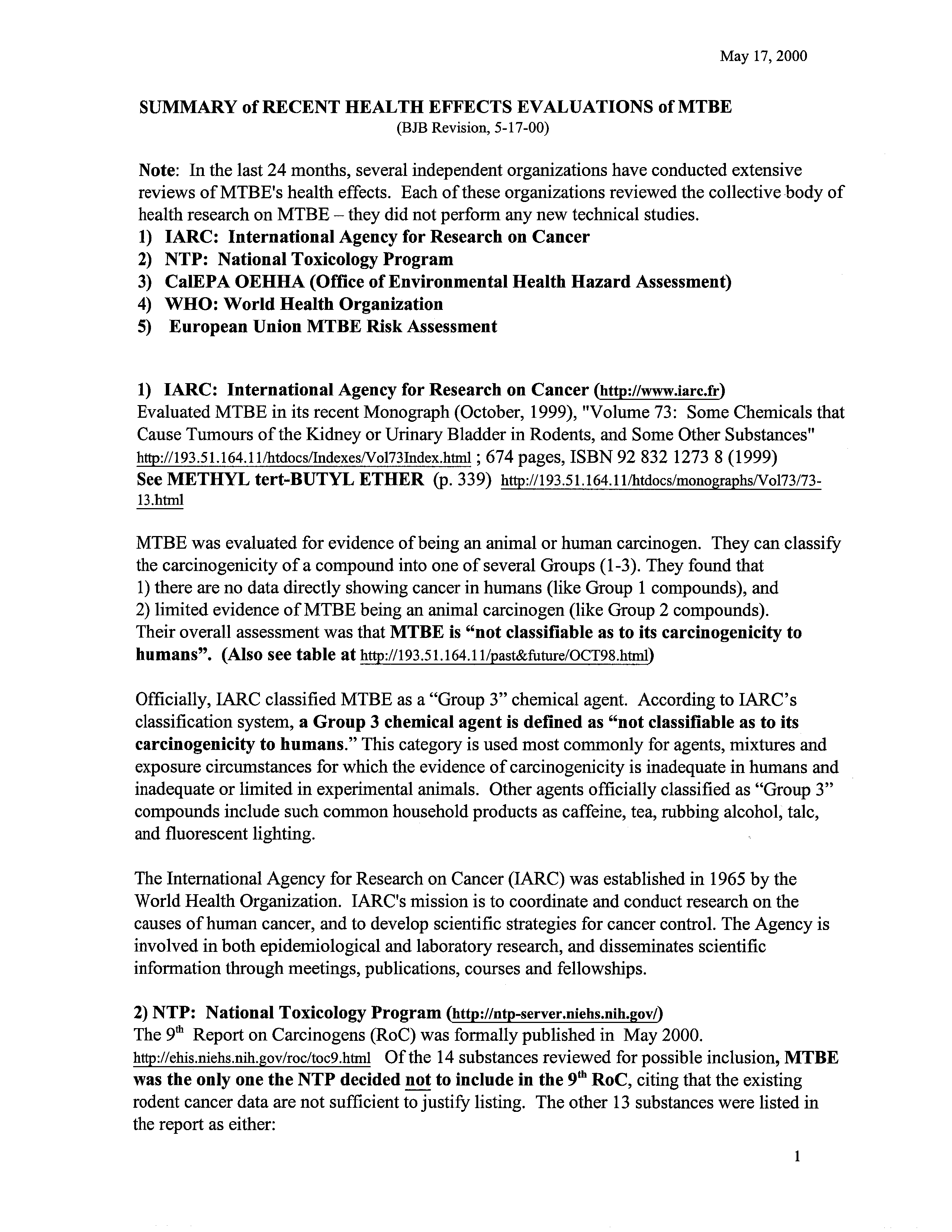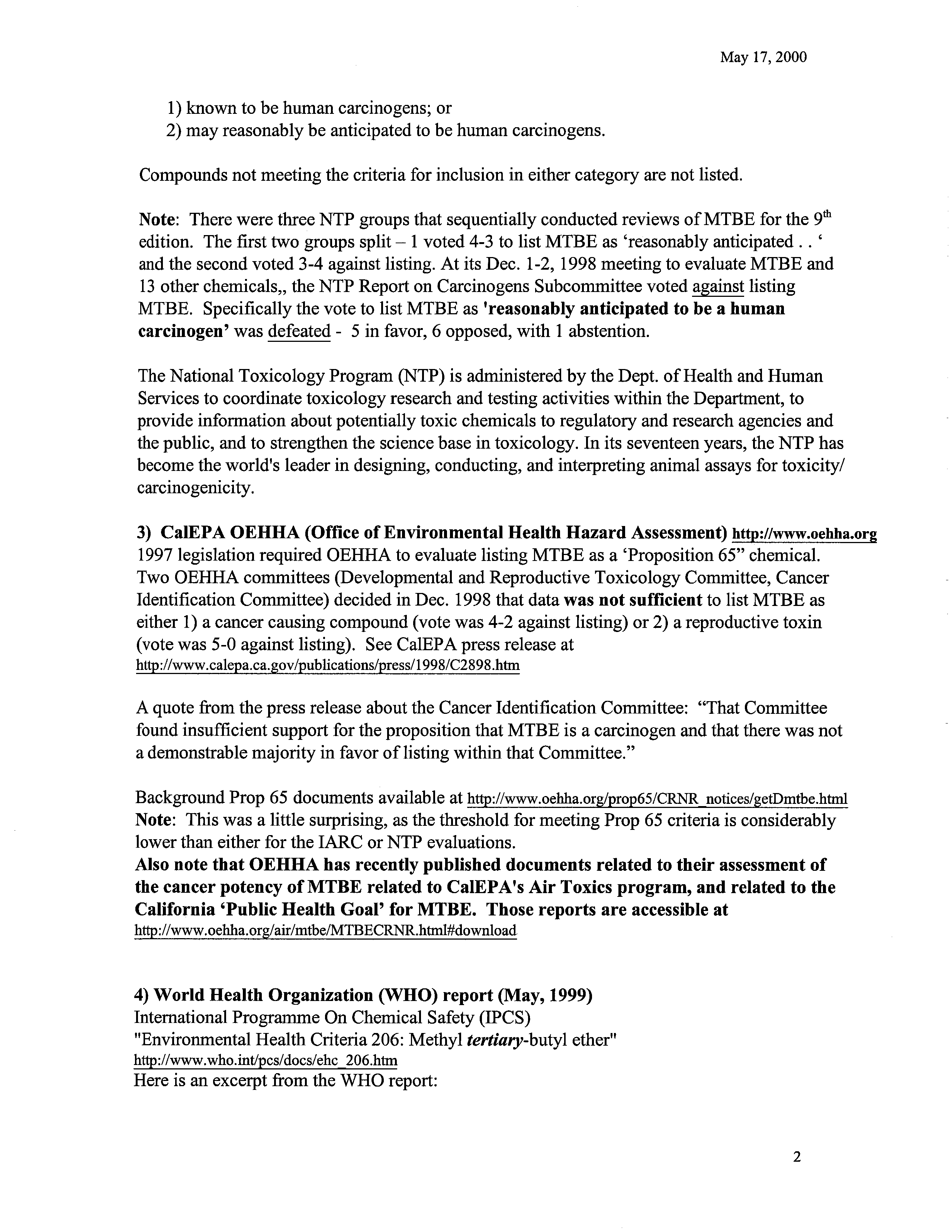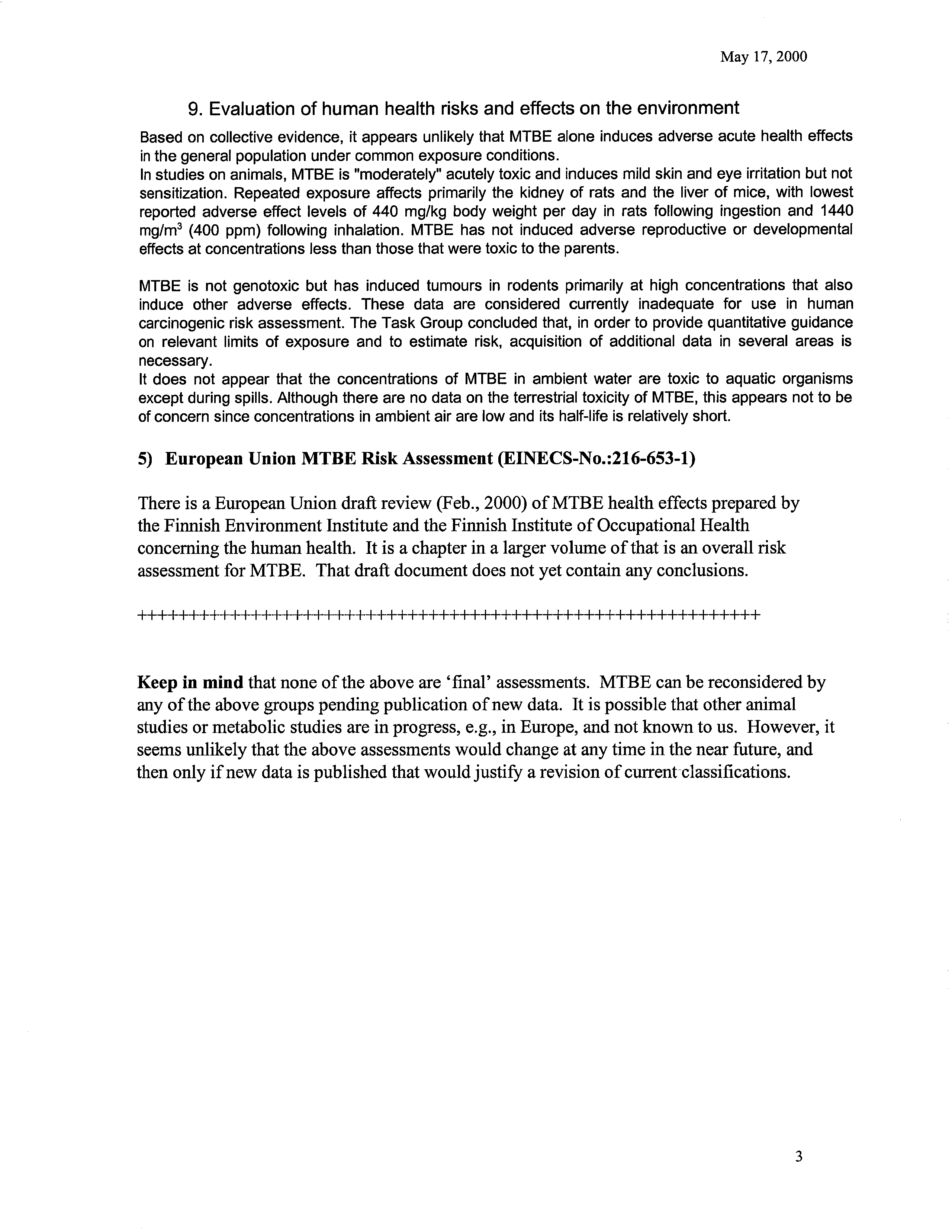IpC_illinois_petroleum
council
DAVID
A. SYKUTA
P.O.
Box
12047
•
400
W.
M
62791
•
217/544-7404
•
FAX
217/523-5131
Executive Di,ector
RE
C
EI
~P
ED
RONALD S. CARDONI
CLERK’S
OP~1CE
Associate Director
October 30, 2001
NOV
1
-
2001
STATE OF
ILLINOIS
Pollution Control Board
Ms. Dorothy M. Gunn, Clerk
Illinois Pollution Control Board
James R. Thompson Center
100 West Randolph Drive, Suite 11-500
Chicago, Illinois
60601
RE:
Docket R-00-19(c)
Dear Ms.
Guim:
Enclosed are comments submifted for the record by the Illinois Petroleum Council
in regard to Docket R-00-19(c) which adds MTBE
as a constituent to be tested for
during a site remediation under part 742 ofthe Board’s land regulations.
Attached is a summary of actions taken by a number ofgovernmental agencies
that have chosen not to classify MTBE as a carcinogen.
We would urge the
Board to
consider a similar ruling.
Sincerely,
David A. Syku a
RECEIVED
CLERK’S
OFFICE
NOV
1
-
2001
BEFORE THE ILLINOIS
POLLUTION CONTROL BOARD
STATE OF IWNOIS
Pollution Control Board
INTHEMATTEROF:
)
)
R00-19(C)
PROPOSED AMENDMENTS TO TIERED
)
(Rulemaking
-
Land)
APPROACH TO CORRECTIVEACTION
)
OBJECTIVES (TACO) (MTBE): 35
ILL.
)
ADM. CODE 742
)
COMMENTS OF
THE
ILLINOIS PETROLEUM COUNCIL
The illinois Petroleum Council (“IPC”) filesthesecomments in responseto theBoard’s First
Notice Order of September 6, 2001. The IPC supports the Board’s action in adopting the illinois
Environmental
Protection Agency’s proposed MTBE standards.
As
the Agency
indicaled in its
comments
on
First
Notice, the record
compiled
before
the
Board
included
a
comprehensive
discussion of
the scientific information
available regarding MTBE and
supports the proposed
standards. The Agency’sprocess ofarriving attheproposed standards reflected theirprocedures for
proposing other TACO values and groundwater protection standards which have been adopted by
the Board. Noone testified in opposition to
theproposed standard during the hearing or submitted
comments prior to the close of the record during the Subdocket B proceedings.
In light ofthis
complete record in support ofthe proposal, the Board should adopt theMTBE values proposedby
the Agency.
In
its
First
Notice opinion,
however,
the
Board
questioned
both
the
current status
of
determinations ofthe possibility ofhuman carcinogenicity ofMTBE and its authority to evaluate
suchdetenninationsoutsideofthestatutory frameworkof thefflinois Environmental ProtectionAct.
Section
58.2
(415
ILCS
5/58.2)
of the
Act
specifically
defines
“carcinogen” in
terms
of the
determinations offour respected agencies in order to ensure that the Board set
TACO standards on
thebasis ofthebest science available. The listed
organizations have theresources and expertise to
fully evaluatethe myriad studies performedon different chemicals and to make decisions based
on
a completerecordsubject to peerreview. The determinations
ofthese
agencies should, in any event,
be given greatweight by the Board and the Act
simply
confirms that the Board is bound to respect
their findings.
Per the Board’s suggestion,
the
IPC has gathered the most recent evaluations of
MTBE by the main independenthealth organizations. The findings ofthese evaluations are listed
in theattacheddocument These findings indicate that MTBEhas notbeendetenninedio beahuman
carcinogen and doesnot fail into thecategories required by theAct for the Board to determinethat
it should be treated as a carcinogen.
The Board should adoptthe proposed standardfor its final rule. The complete record
before the Board supports the adoption ofthis standard and there is no contrary information in the
record which would support the adoption ofany other standard.As always, the IPC appreciatesthe
opportunity to submit these comments.
ILLINOIS PETROLEUM COUNCIL
By___________________
Executive
Director
Date:
October
30,
2001
2
May
17, 2000
SUMMARY of
RECENT
HEALTH EFFECTS EVALUATIONS ofMTBE
(BiB
Revision,
5-17-00)
Note:
In the last 24 months, several independent organizations have conducted extensive
reviews ofMTBE’s health effects.
Each ofthese organizations reviewed the collective-body of
health research on MTBE
—
they did not perform any new technical studies.
1)
IARC:
International Agency for Research on Cancer
2)
NTP:
National Toxicology Program
3)
Ca1EPA OEHHA (Office of Environmental Health Hazard Assessment)
4)
WHO: World Health Organization
5)
European Union MTBE
Risk Assessment
1)
IARC:
International Agency for Research on Cancer
(http://www.iarc.fr)
Evaluated MTBE in its recent Monograph (October,
1999), “Volume 73:
Some Chemicals that
Cause Tumours ofthe Kidney orUrinary Bladder in Rodents,
and Some Other Substances”
http://193.51.164.1 1/htdocs/Indexes/Vol73Index.html
674 pages,
ISBN 92
832 1273
8
(1999)
See METHYL tert-BUTYL ETHER
(p.
339)
http://1
93.51.164.1 1/htdocs/monographs/Vo173/73-
13.html
MTBE was evaluated for evidence ofbeing an animal or human carcinogen.
They can classif~’
the carcinogenicity ofa compound into one ofseveral Groups (1-3). They found that
1) there are no data directly showing cancer in humans (like Group
1
compounds), and
2) limited evidence ofMTBE being an animal carcinogen (like Group 2
compounds).
Their overall assessment was that
MTBE
is
“not classifiable as to its carcinogenicity to
humans”.
(Also see table at
http://193.51.164.1 1/past&future/0CT98.html)
Officially, IARC classified MTBE as a “Group 3” chemical agent.
According to IARC’s
classification system, a
Group
3 chemical agent is defined
as “not classifiable as to its
carcinogenicity to humans.” This
category is used most commonly for agents, mixtures and
exposure circumstances forwhich the evidence ofcarcinogenicity is inadequate in humans and
inadequate or limited in experimental animals.
Other agents officially classified as “Group 3”
compounds include such common household products as caffeine, tea, rubbing alcohol, talc,
and fluorescent lighting.
The International Agency for Research on
Cancer (IARC) was established in 1965 by the
World Health Organization.
IARC’s mission is to
coordinate and conduct research on the
causes ofhuman cancer,
and to develop scientific strategies for cancer control. The Agency is
involved in both epidemiological and laboratory research, and disseminates scientific
information through meetings, publications, courses and fellowships.
2) NTP:
National
Toxicology Program
(http://ntp-server.niehs.nih.gov/)
The
9th
Report on Carcinogens (RoC) was formally published in
May 2000.
http://ehis.niehs.nih.gov/roc/toc9.html
Of the 14 substances reviewed for possible inclusion,
MTBE
was the only one the NTP decided not to include in the
9th
RoC,
citing that the existing
rodent cancer data are not sufficient to justify listing.
The other
13 substances were listed in
the report as either:
1
May 17, 2000
1) known to be human carcinogens;
or
2) may reasonably be anticipated to be human carcinogens.
Compounds not meetingthe criteria for inclusion in either category are not listed.
Note:
There were three NTP groups that sequentially conducted reviews ofMTBE for the
9th
edition.
The first two groups split
—
1
voted 4-3 to list MTBE as ‘reasonably anticipated..’
and the second voted 3-4 against listing. At its
Dec.
1-2,
1998 meeting to evaluate MTBE and
13 other chemicals,, the NTP Report on Carcinogens Subcommittee voted against listing
MTBE.
Specifically the vote to list MTBE as
‘reasonably
anticipated to be
a human
carcinogen’ was defeated
-
5
in favor,
6 opposed, with
1
abstention.
The National Toxicology Program (NTP) is administered by the Dept. ofHealth and Human
Servicesto coordinate toxicology research and testing activities within the Department, to
provide information about potentially toxic chemicals to regulatory and research agencies and
thepublic,
and to
strengthenthe science base in toxicology. In its
seventeen years, the NTP has
become the world’s leader in designing, conducting, and interpreting animal assays for toxicity!
carcinogenicity.
3)
CaIEPA OEHHA (Office of Environmental Health Hazard Assessment)
http://www.oehha.org
1997 legislation required OEHHA to evaluate listing MTBE as a ‘Proposition
65”
chemical.
Two OEHHA committees (Developmental and Reproductive Toxicology Committee,
Cancer
Identification Committee) decided in Dec.
1998 that datawas
not
sufficient to
list MTBE as
either
1) a cancer causing compound (votewas 4-2 against listing) or 2) a reproductive toxin
(vote was
5-0
against listing).
See Ca1EPA press release at
http://www.calepa.ca.gov/publications/press/1 998/C2898.htm
A quote from the press release aboutthe Cancer Identification Committee:
“That Committee
found insufficient support forthe proposition that MTBE is a carcinogen and that there was not
a demonstrable majority in favor oflisting within that Committee.”
Background Prop
65
documents available at http://www.oehha.org/prop65/CRNR
notices/getDmtbe.html
Note:
This was a little surprising, as the threshold for meeting Prop
65
criteria is considerably
lower than either for the IARC or NTP evaluations.
Also note that OEHHA has recently published documents related to their assessment of
the cancer potency ofMTBE related to CaIEPA’s Air Toxics program,
and related to the
California ‘Public Health Goal’ for MTBE.
Those reports are accessible at
http://www.oehha.org/air/mtbe/MTBECRNR.html#download
4)
World Health Organization (WHO) report
(May,
1999)
International Programme On Chemical Safety (IPCS)
“Environmental Health Criteria 206: Methyl
tertiary-butyl
ether”
http://www.who.int/pcs/docs/ehc
206.htm
Here is an excerpt from the WHO report:
2
May
17, 2000
9. Evaluation of human health
risks and effects on the environment
Based on collective evidence,
it appears unlikely that MTBE alone induces
adverse acute health effects
in the general population under common exposure conditions.
In studies on animals, MTBE is “moderately” acutely toxic and induces mild skin and eye irritation but not
sensitization.
Repeated
exposure affects
primarily
the
kidney
of rats
and the
liver
of mice,
with
lowest
reported
adverse
effect
levels
of
440 mg/kg
body weight
per day
in
rats
following
ingestion
and
1440
mg/rn3
(400
ppm)
following
inhalation.
MTBE
has
not
induced
adverse
reproductive
or
developmental
effects at concentrations less than those that were toxic to the parents.
MTBE
is
not
genotoxic
but
has
induced
tumours
in
rodents
primarily
at
high concentrations
that
also
induce
other
adverse
effects.
These
data
are
considered
currently
inadequate
for
use
in
human
carcinogenic risk assessment. The Task Group concluded that,
in order to provide quantitative guidance
on
relevant
limits
of exposure
and
to
estimate
risk,
acquisition
of
additional
data
in
several
areas
is
necessary.
It
does
not
appear
that
the
concentrations
of
MTBE
in
ambient water are
toxic
to
aquatic
organisms
except during spills. Although there are no data on the terrestrial toxicity of MTBE, this appears not to be
of concern since concentrations in ambient air are low and
its half-life is relatively short.
5)
European Union
MTBE Risk Assessment (EINECS-No.:216-653-1)
There
is
a
European Union draft review (Feb., 2000) ofMTBE health effects prepared by
the Finnish Environment Institute and the Finnish Institute ofOccupational Health
concerning the human health.
It is a chapter in a larger volume ofthat is an overall risk
assessment for MTBE.
That draft document does not yet contain any conclusions.
Keep in mind that none of
the above are ‘final’ assessments.
MTBE canbe reconsidered by
any ofthe above groups pending publication ofnew data.
It is possible that other animal
studies or metabolic studies are in progress, e.g.,
in Europe, and not known to us.
However, it
seems unlikely that the above assessments would change at any time in the near future, and
then only if new data is published that would justify a revision ofcurrent-classifications.
3


